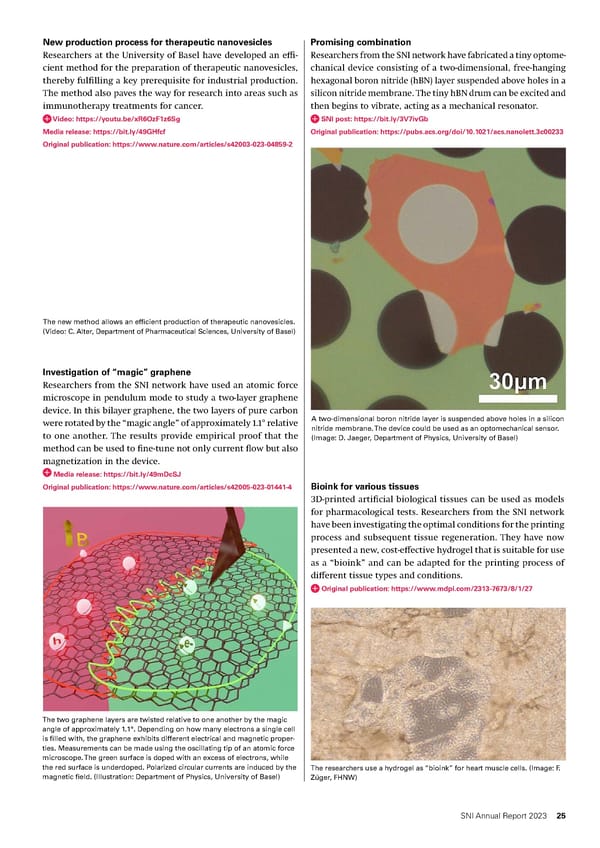New production process for therapeutic nanovesicles Promising combination Researchers at the University of Basel have developed an e昀케- Researchers from the SNI network have fabricated a tiny optome- cient method for the preparation of therapeutic nanovesicles, chanical device consisting of a two-dimensional, free-hanging thereby ful昀椀lling a key prerequisite for industrial production. hexagonal boron nitride (hBN) layer suspended above holes in a The method also paves the way for research into areas such as silicon nitride membrane. The tiny hBN drum can be excited and immunotherapy treatments for cancer. then begins to vibrate, acting as a mechanical resonator. Video: https://youtu.be/xR6OzF1z6Sg SNI post: https://bit.ly/3V7ivGb Media release: https://bit.ly/49GHfcf Original publication: https://pubs.acs.org/doi/10.1021/acs.nanolett.3c00233 Original publication: https://www.nature.com/articles/s42003-023-04859-2 The new method allows an ef昀椀cient production of therapeutic nanovesicles. (Video: C. Alter, Department of Pharmaceutical Sciences, University of Basel) Investigation of “magic” graphene Researchers from the SNI network have used an atomic force microscope in pendulum mode to study a two-layer graphene device. In this bilayer graphene, the two layers of pure carbon were rotated by the “magic angle” of approximately 1.1° relative A two-dimensional boron nitride layer is suspended above holes in a silicon to one another. The results provide empirical proof that the nitride membrane. The device could be used as an optomechanical sensor. (Image: D. Jaeger, Department of Physics, University of Basel) method can be used to 昀椀ne-tune not only current 昀氀ow but also magnetization in the device. Media release: https://bit.ly/49mDcSJ Original publication: https://www.nature.com/articles/s42005-023-01441-4 Bioink for various tissues 3D-printed arti昀椀cial biological tissues can be used as models for pharmacological tests. Researchers from the SNI network have been investigating the optimal conditions for the printing process and subsequent tissue regeneration. They have now presented a new, cost-e昀昀ective hydrogel that is suitable for use as a “bioink” and can be adapted for the printing process of di昀昀erent tissue types and conditions. Original publication: https://www.mdpi.com/2313-7673/8/1/27 The two graphene layers are twisted relative to one another by the magic angle of approximately 1.1°. Depending on how many electrons a single cell is 昀椀lled with, the graphene exhibits different electrical and magnetic proper- ties. Measurements can be made using the oscillating tip of an atomic force microscope. The green surface is doped with an excess of electrons, while the red surface is underdoped. Polarized circular currents are induced by the The researchers use a hydrogel as “bioink” for heart muscle cells. (Image: F. magnetic 昀椀eld. (Illustration: Department of Physics, University of Basel) Züger, FHNW) SNI Annual Report 2023 25
 Annual Report 2023 Page 24 Page 26
Annual Report 2023 Page 24 Page 26